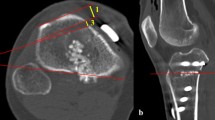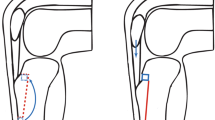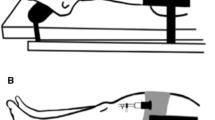Abstract
Purpose
The purpose of this study was to develop a safe and effective method of inserting one tuberosity screw and to determine whether retro-tubercular (RT)-Open-wedge high tibial osteotomy (OWHTO) with tuberosity screw fixation can be conducted to overcome the problem of osteotomized tubercle and produce favorable outcomes compared to RT-OWHTO without tuberosity screw fixation.
Methods
From 2018 to 2020, patients who underwent bi-planar RT-OWHTO were allocated as two groups (RT-OWHTO without tuberosity screw fixation as group I and with screw fixation as group II). Computed tomography (CT) was used to analyze osteotomy configurations such as RT gap and tip distance, and union of the main and second plane osteotomy sites. The RT gap distance was measured as the length of the osteotomy gap. The RT tip distance was measured as the length of the gap at the tip of the tibial tubercle. Post-operative complications were analyzed also. To evaluate the neurovascular (NV) approximity of screw fixation group, the pre-operative magnetic resonance imaging (MRI) images were referenced on the post-operative CT for the assessment of the safe zone.
Results
In total, 44 knees in group I and 46 knees in group II were enrolled. The RT gap distance (2.58 ± 0.69 mm vs. 0.57 ± 0.57 mm; p < .001) and RT tip distance (4.31 ± 1.60 mm vs. 1.48 ± 1.42 mm; p < .001) were significantly larger in group I than in group II. The sum of union grade in the second plane osteotomy site (17.93 ± 2.18 points vs. 22.24 ± 2.57 points; p < .001) was statistically different between two groups at three months post operatively. Post-operative tuberosity prominence occurred in five knees only in group I (p = 0.025), although tibial tuberosity fracture developed in seven cases in group II compared with two cases in group I with no statistical significance. NV was safe when the screw was inserted medially.
Conclusion
RT-OWTHO with one-screw fixation for the tuberosity was effective in terms of tuberosity prominence and the union of the second plane osteotomy site. However, it also produced another problem, such as tuberosity fracture. In addition, a tuberosity screw was safe when it was inserted in the medial–distal direction.
Level of evidence
Cohort study; level III.






Similar content being viewed by others
References
Bin SI, Kim HJ, Ahn HS, Rim DS, Lee DH (2016) Changes in patellar height after opening wedge and closing wedge high tibial osteotomy: a meta-analysis. Arthroscopy 32:2393–2400
Choi CH, Lee WS, Jung M, Moon HS, Lee YH, Oh J et al (2020) Adequate protection rather than knee flexion prevents popliteal vascular injury during high tibial osteotomy: analysis of three-dimensional knee models in relation to knee flexion and osteotomy techniques. Knee Surg Sports Traumatol Arthrosc 28:1425–1435
Chun KC, So BJ, Kang HT, Chun CH (2018) Pseudoaneurysm formation due to popliteal artery injury caused by drilling during medial opening wedge high tibial osteotomy. Knee Surg Relat Res 30:364–368
Clement ND, Bardgett M, Weir D, Holland J, Gerrand C, Deehan DJ (2018) What is the minimum clinically important difference for the WOMAC index after TKA? Clin Orthop Relat Res 476:2005–2014
Ding T, Tan Y, Tian X, Xue Z, Ma S, Hu Y et al (2022) Patellar height after high tibial osteotomy of the distal tibial tuberosity: a retrospective study of age stratification. Comput Math Methods Med 2022:7193902
El-Azab H, Glabgly P, Paul J, Imhoff AB, Hinterwimmer S (2010) Patellar height and posterior tibial slope after open- and closed-wedge high tibial osteotomy: a radiological study on 100 patients. Am J Sports Med 38:323–329
Erquicia J, Gelber PE, Perelli S, Ibanez F, Ibanez M, Pelfort X et al (2019) Biplane opening wedge high tibial osteotomy with a distal tuberosity osteotomy, radiological and clinical analysis with minimum follow-up of 2 years. J Exp Orthop 6:10
Gaasbeek R, Welsing R, Barink M, Verdonschot N, van Kampen A (2007) The influence of open and closed high tibial osteotomy on dynamic patellar tracking: a biomechanical study. Knee Surg Sports Traumatol Arthrosc 15:978–984
Gaasbeek RD, Sonneveld H, van Heerwaarden RJ, Jacobs WC, Wymenga AB (2004) Distal tuberosity osteotomy in open wedge high tibial osteotomy can prevent patella infera: a new technique. Knee 11:457–461
Hernigou J, Chahidi E, Kashi M, Moest E, Dakhil B, Hayek G et al (2018) Risk of vascular injury when screw drilling for tibial tuberosity transfer. Int Orthop 42:1165–1174
Jiang X, Xie K, Han X, Ai S, Wu H, Wang L et al (2022) HKA angle-a reliable planning parameter for high tibial osteotomy: a theoretical analysis using standing whole-leg radiographs. J Knee Surg 35:54–60
Jo IH, Lee OS, Lee SH, Kim KW, Lee YS (2019) Retro-tubercular gap widening can be caused by inappropriate anterior osteotomy and large opening gap in the medial biplanar open-wedge HTO. Knee Surg Sports Traumatol Arthrosc 27:2910–2916
Kang BY, Lee DK, Kim HS, Wang JH (2022) How to achieve an optimal alignment in medial opening wedge high tibial osteotomy? Knee Surg Relat Res 34:3
Kang T, Lee DW, Park JY, Han HS, Lee MC, Ro DH (2020) Sawing toward the fibular head during open-wedge high tibial osteotomy carries the risk of popliteal artery injury. Knee Surg Sports Traumatol Arthrosc 28:1365–1371
Kim JS, Lee JI, Choi HG, Yoo HJ, Jung YS, Lee YS (2021) Retro-tubercle biplanar opening wedge high tibial osteotomy is favorable for the patellofemoral joint but not for the osteotomized tubercle itself compared with supra-tubercle osteotomy. Arthroscopy 37:2567–2578
Kline AJ, Gonzales J, Beach WR, Miller MD (2006) Vascular risk associated with bicortical tibial drilling during anteromedial tibial tubercle transfer. Am J Orthop (Belle Mead NJ) 35:30–32
Krause M, Drenck TC, Korthaus A, Preiss A, Frosch KH, Akoto R (2018) Patella height is not altered by descending medial open-wedge high tibial osteotomy (HTO) compared to ascending HTO. Knee Surg Sports Traumatol Arthrosc 26:1859–1866
LaPrade RF, Oro FB, Ziegler CG, Wijdicks CA, Walsh MP (2010) Patellar height and tibial slope after opening-wedge proximal tibial osteotomy: a prospective study. Am J Sports Med 38:160–170
Lee OS, Ahn S, Lee YS (2017) Effect and safety of early weight-bearing on the outcome after open-wedge high tibial osteotomy: a systematic review and meta-analysis. Arch Orthop Trauma Surg 137:903–911
Lee OS, Lee ES, Lee YS (2019) Disparity between preoperative target correction amount and postoperative correction amount in open wedge high tibial osteotomy. Knee Surg Relat Res 31:126–131
Lee YS, Kang JY, Lee MC, Oh WS, Elazab A, Song MK (2016) Effect of the osteotomy length on the change of the posterior tibial slope with a simple distraction of the posterior gap in the uni- and biplanar open-wedge high tibial osteotomy. Arthroscopy 32:263–271
Lee YS, Kim MK, Byun HW, Kim SB, Kim JG (2015) Reliability of the imaging software in the preoperative planning of the open-wedge high tibial osteotomy. Knee Surg Sports Traumatol Arthrosc 23:846–851
Lee YS, Lee MC, Kang SG, Elazab A, Oh WS (2016) Open-wedge high tibial osteotomy using a protective cutting system: technical advancement for the accuracy of the osteotomy and avoiding intraoperative complications. Arthrosc Tech 5:e7–e10
Lee YS, Lee SB, Oh WS, Kwon YE, Lee BK (2016) Changes in patellofemoral alignment do not cause clinical impact after open-wedge high tibial osteotomy. Knee Surg Sports Traumatol Arthrosc 24:129–133
Lee YS, Moon GH (2015) Comparative analysis of osteotomy accuracy between the conventional and devised technique using a protective cutting system in medial open-wedge high tibial osteotomy. J Orthop Sci 20:129–136
Longino PD, Birmingham TB, Schultz WJ, Moyer RF, Giffin JR (2013) Combined tibial tubercle osteotomy with medial opening wedge high tibial osteotomy minimizes changes in patellar height: a prospective cohort study with historical controls. Am J Sports Med 41:2849–2857
Martimbianco AL, Calabrese FR, Iha LA, Petrilli M, Lira Neto O, Carneiro Filho M (2012) Reliability of the “American Knee Society Score” (AKSS). Acta Ortop Bras 20:34–38
Nha KW, Kim HJ, Ahn HS, Lee DH (2016) Change in posterior tibial slope after open-wedge and closed-wedge high tibial osteotomy: a meta-analysis. Am J Sports Med 44:3006–3013
Noyes FR, Mayfield W, Barber-Westin SD, Albright JC, Heckmann TP (2006) Opening wedge high tibial osteotomy: an operative technique and rehabilitation program to decrease complications and promote early union and function. Am J Sports Med 34:1262–1273
Ogawa H, Matsumoto K, Yoshioka H, Sengoku M, Akiyama H (2020) Distal tibial tubercle osteotomy is superior to the proximal one for progression of patellofemoral osteoarthritis in medial opening wedge high tibial osteotomy. Knee Surg Sports Traumatol Arthrosc 28:3270–3278
Seo H, Lim D, Jang YW, Kang KS, Lee MC, Lee OS et al (2020) Distribution of the force in the knee joint during daily activities after open wedge high tibial osteotomy: a rationale for the proper postoperative management. J Knee Surg 33:158–166
Shetty AA, Tindall AJ, Nickolaou N, James KD, Ignotus P (2005) A safe zone for the passage of screws through the posterior tibial cortex in tibial tubercle transfer. Knee 12:99–101
Shin YS, Sim HB, Yoon JR (2017) Tibial nerve neuropathy following medial opening-wedge high tibial osteotomy-case report of a rare technical complication. Eur J Orthop Surg Traumatol 27:563–567
Song IH, Song EK, Seo HY, Lee KB, Yim JH, Seon JK (2012) Patellofemoral alignment and anterior knee pain after closing- and opening-wedge valgus high tibial osteotomy. Arthroscopy 28:1087–1093
van Hemert WL, Willems K, Anderson PG, van Heerwaarden RJ, Wymenga AB (2004) Tricalcium phosphate granules or rigid wedge preforms in open wedge high tibial osteotomy: a radiological study with a new evaluation system. Knee 11:451–456
Yang JH, Lee SH, Nathawat KS, Jeon SH, Oh KJ (2013) The effect of biplane medial opening wedge high tibial osteotomy on patellofemoral joint indices. Knee 20:128–132
Funding
This work was supported by the National Research Foundation of Korea (NRF) grant funded by the Korea government (MSIT) No.2021R1A2C1092657.
Author information
Authors and Affiliations
Corresponding author
Ethics declarations
Conflict of interest
The authors declare no conflict of interest.
Ethical approval
The article does not contain any studies involving human participants or animals performed by any of the authors. Institutional Review Board approval was obtained before performing the study (B-2205-757-101).
Additional information
Publisher's Note
Springer Nature remains neutral with regard to jurisdictional claims in published maps and institutional affiliations.
Supplementary Information
Below is the link to the electronic supplementary material.
Rights and permissions
About this article
Cite this article
Park, S.B., Kim, J.S., Jeong, H.W. et al. Medially and distally inserted tuberosity screw fixation of the osteotomized tubercle is safe and effective in retro-tubercular bi-planar opening-wedge high tibial osteotomy. Knee Surg Sports Traumatol Arthrosc 31, 1571–1582 (2023). https://doi.org/10.1007/s00167-022-07009-z
Received:
Accepted:
Published:
Issue Date:
DOI: https://doi.org/10.1007/s00167-022-07009-z




